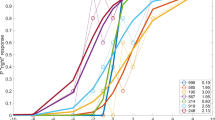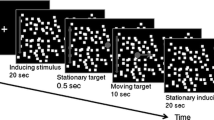Summary
Studies of the linear vestibulo-ocular reflex (LVOR) suggest that eye movement responses to linear head motion are rudimentary. This may be due to inadequate control of target distance (D). As D approaches infinity, eye movements are not required to maintain retinal image stability during linear head displacements, but must become increasingly large as D shortens. The LVOR in the presence of visual targets (VLVOR) was tested by recording human vertical eye and head movements during self-generated vertical linear oscillation (averaging 2.7 Hz at peak excursion of 3.2 cm) while subjects alternately fixated targets at D=36, 142, and 424 cm. Response sensitivity rose from 0.10 deg/cm (5.8 deg/s/g) for D=424 cm to 0.65 deg/cm (37.5 deg/s/g) for D=36 cm. Results employing optical manipulations, including spherical lenses to modify accommodation and accomodative convergence, and prisms to modify fusional vergence without altering accommodation, imply that the state of vergence is the most important variable underlying the effect. Trials in darkness (LVOR) and with head-fixed targets (visual suppression of the LVOR) suggest that, while visual following and perhaps “mental set” influences results, the major proportion of the VLVOR response is driven by vestibular (presumably otolith) inputs.
Similar content being viewed by others
References
Alpern M (1969) Types of eye movements. In: Davson H (ed) The eye, Vol 3. Muscular mechanisms. Academic Press, New York London, pp 65–174
Baarsma EA, Collewijn H (1975) Eye movements due to linear accelerations in the rabbit. J Physiol 245:227–247
Baloh RW, Yee RD, Honrubia V, Jacobson K (1988) A comparison of the dynamics of horizontal and vertical smooth pursuit in normal human subjects. Aviat Space Environ Med 59:121–124
Becker W, Fuchs AF (1985) Prediction in the oculomotor system: smooth pursuit during transient disappearance of a visual target. Exp Brain Res 57:562–575
Benson AJ (1974) Modification of the response to angular accelerations. In: Kornhuber HH (ed) Handbook of sensory physiology, Vol 6/II. Vestibular system. Springer, Berlin Heidelberg New York, pp 281–320
Berthoz A, Isreal I, Vieville T, Zee D (1987) Linear head displacement measured by the otoliths can be reproduced through the saccadic system. Neurosci Lett 82:285–290
Biguer B, Prablanc C (1981) Modulation of the vestibulo-ocular reflex in eye-head orientation as a function of target distance in man. In: Fuchs AF, Becker W (ed) Progress in oculomotor research. Elsevier, Amsterdam, pp 525–530
Blakemore C, Donaghy M (1980) Co-ordination of head and eyes in the gaze changing behavior of cats. J Physiol 300:317–335
Bronstein AM, Gresty MA (1988) Short latency compensatory eye movement responses to transient linear head acceleration: a specific function of the otolith-ocular reflex. Exp Brain Res 71:406–410
Buizza A, Léger A, Droulez J, Berthoz A, Schmid R (1980) Influence of otolithic stimulation by horizontal linear acceleration on optokinetic nystagmus and visual motion perception. Exp Brain Res 39:165–176
Fernández C, Goldberg JM (1976) Physiology of peripheral neurons innervating otolith organs of the squirrel monkey. I. Response to static tilts and to long-duration centrifugal force. J Neurophysiol 39:970–984
Hine T, Thorn F (1987) Compensatory eye movements during active head rotation for near targets: effects of imagination, rapid head oscillation and vergence. Vision Res 27:1639–1657
Lichtenberg BK, Young LR, Arrott AP (1982) Human ocular counterrolling induced by varying linear accelerations. Exp Brain Res 48:127–136
Melvill Jones G, Rolph R, Downing GH (1980) Comparison of human subjective and oculomotor responses to sinusoidal vertical linear acceleration. Acta Otolaryngol 90:431–440
Miles FA, Kawano K, Optican LM (1986) Short-latency ocular following responses of monkey. I. Dependence of temporospatial properties of visual input. J Neurophysiol 56:1321–1354
Niven JL, Hixson WC, Correia MJ (1966) Elicitation of horizontal nystagmus by periodic linear acceleration. Acta Otolaryngol 62:429–441
Paige GD (1986) Vestibulo-ocular reflex (VOR) during vertical linear motion. Neuroscience Abstr 12:253
Paige GD, Tomko DL (1988) Linear vestibulo-ocular reflex (LVOR) of squirrel monkey. II. Visual-vestibular interactions. Neuroscience Abstr 14:332
Post RB, Leibowitz HW (1982) The effect of convergence on the vestibulo-ocular reflex and implications for perceived movement. Vision Res 22:461–465
Robinson DA (1963) A method of measuring eye movement using a scleral search-coil in magnetic field. IEEE Trans Biomed Eng 10:137–145
Semmlow JL (1981) Oculomotor responses to near stimuli: the near triad. In: Zuber L (ed) Models of oculomotor behavior and control. CRC Press, Boca Raton, pp 161–191
Tokita T, Miyata H, Masaki M, Ikeda S (1981) Dynamic characteristics of the otolith oculomotor system. In: Cohen B (ed) Vestibular and oculomotor physiology. International meeting of the Barany Society. Ann N Y Acad Sci 374:56–58
Viirre E, Tweed D, Milner K, Vilis TA (1986) Reexamination of the gain of the vestibuloocular reflex. J Neurophysiol 56:439–450
Author information
Authors and Affiliations
Rights and permissions
About this article
Cite this article
Paige, G.D. The influence of target distance on eye movement responses during vertical linear motion. Exp Brain Res 77, 585–593 (1989). https://doi.org/10.1007/BF00249611
Received:
Accepted:
Issue Date:
DOI: https://doi.org/10.1007/BF00249611




